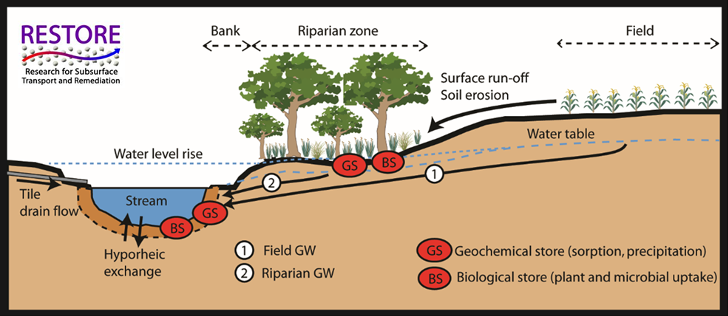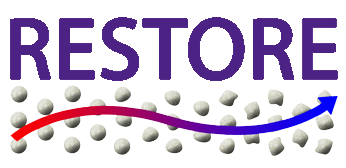Contribution of Groundwater to Phosphorus Inputs to Agricultural Streams
Background
Streams, rivers and lakes across Canada are threatened by excess nutrients, predominately phosphorus, from human activities. Excess nutrients causes eutrophication, algal growth, impairment of aquatic ecosystems, and contamination of drinking water sources. This costs billions of dollars annually due to lost economic, recreational and ecological benefits. With agriculture the dominant contributor of phosphorus to streams, there is an urgent need to decrease agriculturally-derived phosphorus inputs to surface waters. This project focuses on evaluating the importance of groundwater as a pathway for delivering phosphorus to streams and evaluating the way in which groundwater impacts stream ecology. Understanding groundwater phosphorus delivery pathways and the interacting processes is critical to making science-informed decisions and developing effective phosphorus reduction programs and policies.

Groundwater pathways delivering phosphorus to agricultural streams
Project Objectives
The project objective is to provide new knowledge and tools required to assess and manage the contribution and ecological impact of groundwater in delivering P to agricultural streams. The specific objectives include:
- Develop a multi-scale field monitoring platform for evaluating groundwater phosphorus inputs to agricultural streams
- Evaluate the impact of groundwater inputs on stream ecology
- Evaluate key controls on phosphorus delivery from groundwater to streams
Research Methods
Field Investigations
Multi-scale field investigations are being conducted in Kintore Creek subwatershed located in the Lake Erie Basin. These field investigations include (i) large baseflow synoptic surveys to identify groundwater phosphorus inputs to streams, (ii) stream reach-scale investigations to evaluate processes controlling phosphorus behavior near the groundwater-stream interface and the impact of groundwater inputs on stream ecology; and (iii) riparian zone field investigations to evaluate efficacy of riparian zones in retaining phosphorus. We are using state-of-the-art field measurement tools to characterize the dynamic and heterogeneous groundwater-stream exchange patterns, phosphorus retention-release processes, and stream ecology.



Groundwater-surface water field investigations in Kintore Creek, ON
Click here for more project photos
Numerical Reactive Transport Modeling
Numerical reactive transport models will be developed to investigate key controls on phosphorus release from the subsurface to streams. Numerical models will be developed based on findings from the field investigations.
Project Output
Select Conference Presentations
Robinson, K., M. Vissers, C. Power, J.W. Roy, U. Schneidewind, C. Robinson, 2020. Role of groundwater-surface water interactions in delivering phosphorus to agriculture streams, Central Canadian Association of Water Quality Symposium, Toronto.
Wang, S., J.W. Roy, U. Schneidewind, C. Robinson, 2020. Investigation of the Groundwater Phosphorus Dynamics in an Agricultural Riparian Buffer Zone, Central Canadian Association of Water Quality Symposium, Toronto.
Boreux, M., J.W. Roy, A.G. Yates, L. Banks, C.E. Robinson, 2019. Groundwater inflow and nutrient status in agricultural streams during summer and winter base flow, International Association of Great Lakes Research (IAGLR) 2019, Brockport, NY. June 10-14.
Boreux, M., J.W. Roy, A.G. Yates, L. Banks, C.E. Robinson, 2019. Assessing links between groundwater gaining areas and nutrient status in agricultural streams during summer and winter base flow conditions. 2019 Joint Meeting of Geological Association of Canada (GAC), the Mineralogical Association of Canada (MAC) and the Canadian National Chapter of the International Association of Hydrogeologists (IAH/CNC), Quebec City, QC. May 12-15.
Yates, A.J., N. Gotkowski, S. Kroeze, M.P. Boreux, C.E. Robinson and J.W. Roy, 2019. Groundwater fluxes as a driver of spatial patterns of ecological function and structure in a headwater stream network, Society for Freshwater Science Annual Meeting, Salt Lake City, UT, May 19-23.
Journal Papers
Robinson K., C.E. Robinson, J. Roy, M. Vissers, A. Almpanis, U. Schneidewind, C. Power, 2022. Improved interpretation of groundwater-surface water interactions along a stream reach using 3D high-resolution combined DC resistivity and induced polarization (DC-IP) geoelectrical imaging. Journal of Hydrology, 613 (B). DOI:10.1016/j.jhydrol.2022.128468
Project Team
Project Leaders:
Adam Yates (Biology, University of Waterloo)
Project Members:
Lauren Banks, PhD (Biology, University of Waterloo)
Meghan Vissers, MESc (Completed 2022)
Kyle Robinson, MESc (Completed 2021)
Sabina Rakhimbekova, Post doctoral Associate
Max Boreux, Research Associate
Uwe Schneidewind, Post doctoral Associate
Supporting Organizations:






